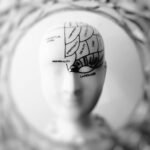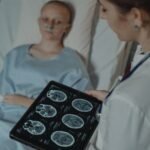Table of Contents
Neurological Disorders
- How Cerebral Hypoxia can lead to brain damage?
- Bipolar Disorder
- Mononeuropathy
- Poliomyelitis
- Neurodegenerative disorders
- Huntington’s disease (HD)
- Cerebral edema
- Migraine
- Brain Hemorrhage
- Epilepsy
- Polyneuropathy
- Encephalitis
- Increased Intracranial Pressure
- Types of Brain Tumors You Should Know About
- Brain Stroke: Symptoms, Diagnosis and Treatment
An acute spinal cord injury (SCI) is a traumatic injury to the spinal cord that results in temporary or permanent damage to the spinal cord and its functions. This type of injury can have serious and life-changing consequences for the affected individual. Here are some key points to understand about acute spinal cord injuries:
Causes of Acute Spinal Cord Injury (SCI)
Acute spinal cord injuries (SCI) are typically the result of traumatic events that cause damage to the spinal cord. These injuries can have severe and often permanent consequences. Here are some common causes of acute spinal cord injuries:
- Motor Vehicle Accidents: Car, motorcycle, bicycle, and pedestrian accidents are among the leading causes of SCI. High-speed collisions can cause severe spinal cord damage.
- Falls: Falls from heights, such as a ladder or a significant elevation, commonly cause SCI. Older adults are particularly vulnerable to SCI from falls.
- Sports Injuries: Certain sports, such as football, rugby, skiing, and gymnastics, can lead to spinal cord injuries, especially when players collide or experience a fall.
- Recreational Activities: Activities like diving into shallow water, horseback riding, or extreme sports can result in spinal cord injuries if proper precautions are not taken.
- Violence: Stabbings, gunshot wounds, and other acts of violence can cause penetrating injuries to the spinal cord.
- Workplace Accidents: Certain jobs, such as construction or industrial work, may carry a higher risk of spinal cord injuries due to falls, equipment accidents, or other workplace hazards.
- Medical Procedures: In rare cases, medical procedures such as spinal surgeries or epidural injections can lead to iatrogenic (healthcare-induced) spinal cord injuries.
- Recreational Vehicle Accidents: Accidents involving ATVs, snowmobiles, or other recreational vehicles can result in SCI.
- Bicycle Accidents: Collisions with motor vehicles or falls from bicycles can lead to spinal cord injuries.
- Acts of Nature: Natural disasters like earthquakes and severe storms can cause injuries, including spinal cord injuries, due to collapsing structures or debris.
- Diving Accidents: Diving into shallow water or pools without checking the depth can lead to SCI if the head strikes the bottom.
Can acute spinal cord injuries be prevented?
It’s important to note that prevention is key to reducing the risk of acute spinal cord injuries. This includes wearing seatbelts in vehicles, using helmets during sports and recreational activities, taking precautions in workplaces, and avoiding risky behaviours. Additionally, improvements in vehicle safety technology, sports equipment, and workplace safety measures have reduced the incidence and severity of spinal cord injuries in some cases.
Check Novel or Innovative Treatment Approach in Neurology
Levels of Injury
The location of the spinal cord injury determines the extent of functional impairment. The spinal cord is divided into 31 segments: cervical 8, thoracic 12, lumbar 5, sacral 5, and coccygeal. , Each segment is responsible for specific functions. The higher the injury on the spinal cord, the more severe the impact on bodily functions. Injuries are often classified as cervical (neck), thoracic (upper back), lumbar (lower back), or sacral (lower spine) based on the affected region.
Know more How does Multiple Sclerosis affect a person’s life?
Symptoms of SCI:
The symptoms of an acute spinal cord injury (SCI) can vary widely depending on the location and severity of the injury. Symptoms can range from mild sensory changes to complete paralysis.
Here are some common symptoms associated with acute spinal cord injuries:
- Loss of Motor Function: One of the hallmark symptoms of an SCI is a loss of motor function, which can vary from weakness to complete paralysis below the level of the injury. The extent of motor impairment depends on the damaged nerve pathways.
- Loss of Sensation: Individuals with an SCI may experience a loss of sensation below the level of the injury. This can manifest as numbness, tingling, or a lack of feeling in the affected body parts.
- Muscle Weakness: Weakness in the muscles below the level of the injury is often present. This can make it difficult for individuals to move limbs or control their muscles properly.
- Changes in Reflexes: Spinal cord injuries can affect reflexes. Hyperreflexia, where reflexes become exaggerated, is expected in the early stages of SCI. As the injury stabilizes, reflexes may decrease or disappear.
- Difficulty Breathing: Depending on the level of the injury, the muscles required for breathing may be affected. This can lead to difficulty breathing, requiring assistance such as mechanical ventilation.
- Loss of Bladder and Bowel Control: Many individuals with SCI lose control over their bladder and bowel function. This can result in urinary and faecal incontinence.
- Spasticity: Muscle spasms and spasticity can occur as a result of SCI. These involuntary muscle contractions can be painful and affect mobility.
- Blood Pressure Instability: SCI can lead to fluctuations in blood pressure, including episodes of dangerously low blood pressure (hypotension) or autonomic dysreflexia, a condition characterized by high blood pressure and other symptoms like headache, sweating, and goosebumps.
- Check Aneurysms: bulging of a blood vessel wall.
- Sexual Dysfunction: SCI can affect sexual function, including erectile dysfunction and changes in sexual sensation.
- Pain: Many individuals with SCI experience chronic pain, which can be neuropathic (related to nerve damage) or musculoskeletal (related to changes in muscle and bone).
- Changes in Body Temperature Regulation: SCI can disrupt the body’s ability to regulate temperature, leading to difficulty staying warm or cool.
- Emotional and Psychological Effects: Coping with an SCI can lead to emotional and psychological challenges, including depression, anxiety, and adjustment issues.
Important to note:
It’s important to note that the specific symptoms of an SCI can vary based on factors such as the level and severity of the injury, as well as individual differences. Prompt medical attention and comprehensive rehabilitation are crucial for individuals with acute spinal cord injuries to maximize their recovery and quality of life. Treatment and management strategies aim to address the specific symptoms and complications associated with the injury.
Diagnosis of Acute Spinal Cord Injury (SCI)
Diagnosing acute spinal cord injury (SCI) involves a combination of clinical evaluation, imaging studies, and medical history assessment. Prompt and accurate diagnosis is crucial for determining the severity and location of the injury and guiding appropriate treatment. Here are the key steps in diagnosing SCI:
Clinical Assessment:
- A healthcare provider will conduct a thorough physical examination, paying close attention to neurological signs and symptoms. They will assess motor function, sensory perception, and reflexes in various body parts.
- The provider will inquire about the circumstances leading to the injury, including the mechanism of injury and any potential associated injuries or symptoms (e.g., loss of consciousness, difficulty breathing).
- Medical History:
- A detailed medical history is obtained to understand the patient’s health, previous medical conditions, medications, and allergies. This information helps guide treatment decisions and assess the risk of complications.
- Imaging Studies:
- Imaging is a critical component of diagnosing SCI. The following imaging modalities are commonly used:
- X-rays are often the first imaging study to assess for fractures or dislocations of the spine. They can provide a preliminary view of the spinal column.
- Computed Tomography (CT) Scan: A CT scan helps obtain detailed spine images, including bone fractures, spinal cord compression, and other abnormalities.
- Magnetic Resonance Imaging (MRI): MRI is a powerful tool for visualizing soft tissues, including the spinal cord and surrounding structures. It can provide information about the location, extent, and severity of spinal cord damage.
Neurological Assessment:
- A neurological examination is conducted to determine the level and completeness of the SCI. The American Spinal Injury Association (ASIA) Impairment Scale is often used to classify the injury and assess neurological function.
Assessment of Autonomic Function:
- Autonomic functions like blood pressure, heart rate, and sweating may be evaluated to identify autonomic dysreflexia. This potentially life-threatening condition can occur with certain types of SCI.
Laboratory Tests:
- Blood tests may be performed to assess the patient’s overall health, including blood cell counts, electrolyte levels, and markers of inflammation.
Specialized Tests:
- In some cases, additional tests such as urodynamic studies (to evaluate bladder function), electromyography (EMG), or somatosensory evoked potentials (SSEPs) may be performed to gather more information about the extent of the injury and its impact on various bodily functions.
Consultation with Specialists:
- Depending on the patient’s condition and the complexity of the injury, consultations with specialists such as neurosurgeons, orthopaedic surgeons, and rehabilitation medicine specialists may be necessary to develop a comprehensive treatment plan.
Points to note:
It’s essential to recognize that diagnosing acute SCI is a complex process that requires a multidisciplinary approach, including input from neurologists, neurosurgeons, radiologists, and rehabilitation specialists. Accurate and timely diagnosis is crucial to guide appropriate treatment decisions and optimize outcomes for individuals with SCI.
How is an acute spinal cord injury treated?
The treatment of acute spinal cord injury (SCI) involves immediate medical care to stabilize the patient, prevent further damage to the spinal cord, and provide ongoing treatment and rehabilitation to maximize recovery and quality of life. Here are the critical aspects of treatment for acute SCI:
Emergency Medical Care:
- Immobilization: One of the priorities is to immobilize the patient’s spine to prevent further damage. This is typically done using a cervical collar, backboard, or other specialized equipment.
- Respiratory Support: In cases where the injury affects the patient’s ability to breathe, mechanical ventilation may be necessary to maintain oxygen levels.
- Circulatory Support: Hemodynamic stability is crucial, so maintaining adequate blood pressure and circulation is a priority.
- Medications: High-dose steroids, such as methylprednisolone, may be administered to reduce inflammation and minimize secondary damage to the spinal cord. However, using steroids is controversial among medical professionals due to its potential risks and benefits.
Surgery:
- Surgery may be required to stabilize the spine, remove bone fragments, or decompress the spinal cord if there is significant pressure.
- Surgical techniques include spinal fusion, fixation with screws and rods, or discectomy to remove herniated disc material.
Rehabilitation:
- After the acute phase of treatment, individuals with SCI typically undergo extensive rehabilitation to regain function and adapt to their condition.
- Rehabilitation may include physical, occupational, and speech therapy depending on the individual’s needs.
- Rehabilitation aims to improve mobility, strength, and functional independence.
Complications Management:
- Individuals with SCI are at risk of various complications, including pressure ulcers (bedsores), muscle contractures, respiratory infections, urinary tract infections, and deep vein thrombosis (blood clots). These complications require ongoing management and preventive measures.
- Medications and therapies may be prescribed to manage neuropathic pain and spasticity.
Assistive Devices and Adaptive Technologies:
- Depending on the level and severity of the SCI, individuals may require assistive devices such as wheelchairs, mobility aids, and adaptive technologies to enhance their independence and quality of life.
Psychological and Emotional Support:
- Coping with an SCI can be emotionally challenging. Mental health support, counselling, and peer support groups can be invaluable in helping individuals and their families adjust to the changes in their lives.
Long-Term Care:
- Many individuals with SCI require long-term care, which may involve ongoing medical monitoring, assistance with daily activities, and continued rehabilitation.
Research and Experimental Treatments:
- Ongoing research into SCI includes exploring potential treatments such as stem cell therapies, neural regeneration techniques, and experimental interventions to restore lost functions.
It’s important to note that the extent of recovery and functional outcomes for individuals with SCI can vary widely based on factors such as the level and severity of the injury, the timeliness of medical treatment, and individual factors. Early intervention and comprehensive care from a multidisciplinary team of healthcare professionals are crucial in optimizing outcomes for individuals with acute spinal cord injuries. Treatment plans are typically tailored to each patient’s specific needs and circumstances.
Points to note:
- It’s important to note that acute spinal cord injuries can have profound physical, emotional, and social impacts on individuals and their families.
- Support networks, adaptive equipment, and assistive technologies can play a crucial role in helping individuals with SCI lead fulfilling lives.
- The prognosis for individuals with acute spinal cord injuries can vary widely.
- Some people may experience partial or complete recovery of function over time, while others may have permanent disabilities.
- The extent of recovery depends on factors like the level and severity of the injury, the timeliness of medical treatment, and the individual’s overall health.
Check Ataxia: Lack of voluntary coordination.
References:
- Acute Spinal Cord Injury |- Johns Hopkins Medicine
- Fehlings, M. G., Tetreault, L. A., Wilson, J. R., Kwon, B. K., Burns, A. S., Martin, A. R., … Harrop, J. S. (2017, September 1). A Clinical Practice Guideline for the Management of Acute Spinal Cord Injury: Introduction, Rationale, and Scope. Global Spine Journal. SAGE Publications Ltd. https://doi.org/10.1177/2192568217703387
- Nadeau, M., Singh, S., Bélanger, L., Noonan, V. K., Hamilton, L., Boyd, M., Fisher, C. (2021). Patient perspective: diagnosis and prognosis of acute spinal cord injuries. Spinal Cord, 59(8), 865–873. https://doi.org/10.1038/s41393-021-00641-5
- Martin, A. R., Aleksanderek, I., & Fehlings, M. G. (2015, September 1). Diagnosis and Acute Management of Spinal Cord Injury: Current Best Practices and Emerging Therapies. Current Trauma Reports. Springer International Publishing. https://doi.org/10.1007/s40719-015-0020-0
- Huang, H., Young, W., Skaper, S., Chen, L., Moviglia, G., Saberi, H., … Feng, S. (2020, January 1). Clinical Neurorestorative Therapeutic Guidelines for Spinal Cord Injury (IANR/CANR version 2019). Journal of Orthopaedic Translation. Elsevier (Singapore) Pte Ltd. https://doi.org/10.1016/j.jot.2019.10.006
















